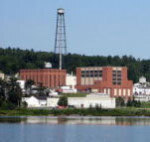Expert Panel Outlines Canada's Options to Reverse Medical Isotope Shortage
by
Brendon Nafziger, DOTmed News Associate Editor | December 11, 2009

Canada's Chalk River
reactor is shut down
An expert panel recommends the Canadian government have in place a new system to make up for the expected medical isotope shortage when the National Research Universal reactor, Canada's isotope-producing workhorse, goes offline for good in the next few years.
The panel, comprising scientists and CEOs drawn from hospitals, laboratories and the Canadian Cancer Society, first convened in June. Their report, submitted to Lisa Raitt, Canada's Natural Resources Minister, on Nov. 30, became public on Dec. 3.
Canada's 52-year-old NRU reactor, once responsible for 30 to 40 percent of the globe's medical isotope supply, is now shutdown, undergoing repairs. Although it's expected to be online again next year, the aging reactor is nearing the end of its life. Even with an expected extension to its license, currently set to expire in October 2011, it likely won't last longer than 2016.
To make up for the shortage of molybdenum-99, whose daughter isotope, technetium-99m, is an important isotope for nuclear medicine, the panel recommends looking into opening one of several new reactors. They even suggest doing away with medical isotopes altogether, perhaps by performing more diagnostic work with PET imaging, which doesn't need Tc-99m.
Best bet: multi-purpose reactor
Of all options considered, the panel believes the lowest-risk one would be a multi-purpose reactor catering to different research functions. "The research reactor also promises the most associated benefits to Canadians based on its multiple purposes," they write.
But the skies are not so clear: a multi-purpose reactor would have the highest up-front capital costs, around $500 million. It would also take the longest to come online, with such a reactor not actually producing medical isotopes for another 10 years. And the non-isotope functions would make up the bulk of the reactor's income. Because of the reactor's expense and the low global price for medical isotopes, the report predicts that revenue from producing Mo-99 would only help recoup at most 15% of the reactor's costs.
Notably, the panel is wary of a dedicated isotope facility (DIF), such as the never-finished one at the Chalk River Laboratories abandoned in spring 2008. They note that no dedicated medical isotope reactor has ever been completed anywhere in the world, possibly because with the price of isotopes kept so low it's not profitable to do so.
One experimental option the panel recommends plunking R&D money into is cyclotrons. Cyclotrons could be used, the panel argues, to shower the isotope molybdenum-100 with protons to directly produce Tc-99m. The benefits are many: cyclotrons create little waste, and they're among the least expensive, and quickest-to-build, options. The panel thinks the system could be in place as early as 2011.
If this proves feasible, the main drawback is the short half-life of Tc-99m, which means each cyclotron could only serve local radiopharmacies. However, the panel estimates that around eight cyclotrons spread out across Canada - supplemented, perhaps by other reactors, could meet the nation's medical isotope needs.
Low enrichment, high priority
One of the key themes threaded throughout the panel's guidelines was honoring Canada's non-proliferation commitments by moving away from facilities such as NRU that process high-enrichment uranium, which can also be used to make weapons.
But whether that, and the other suggestions, get taken up remains to be seen. This summer, Canada's Prime Minister Stephen Harper said once NRU shuts down, Canada would move out of the medical isotope-producing industry altogether.
